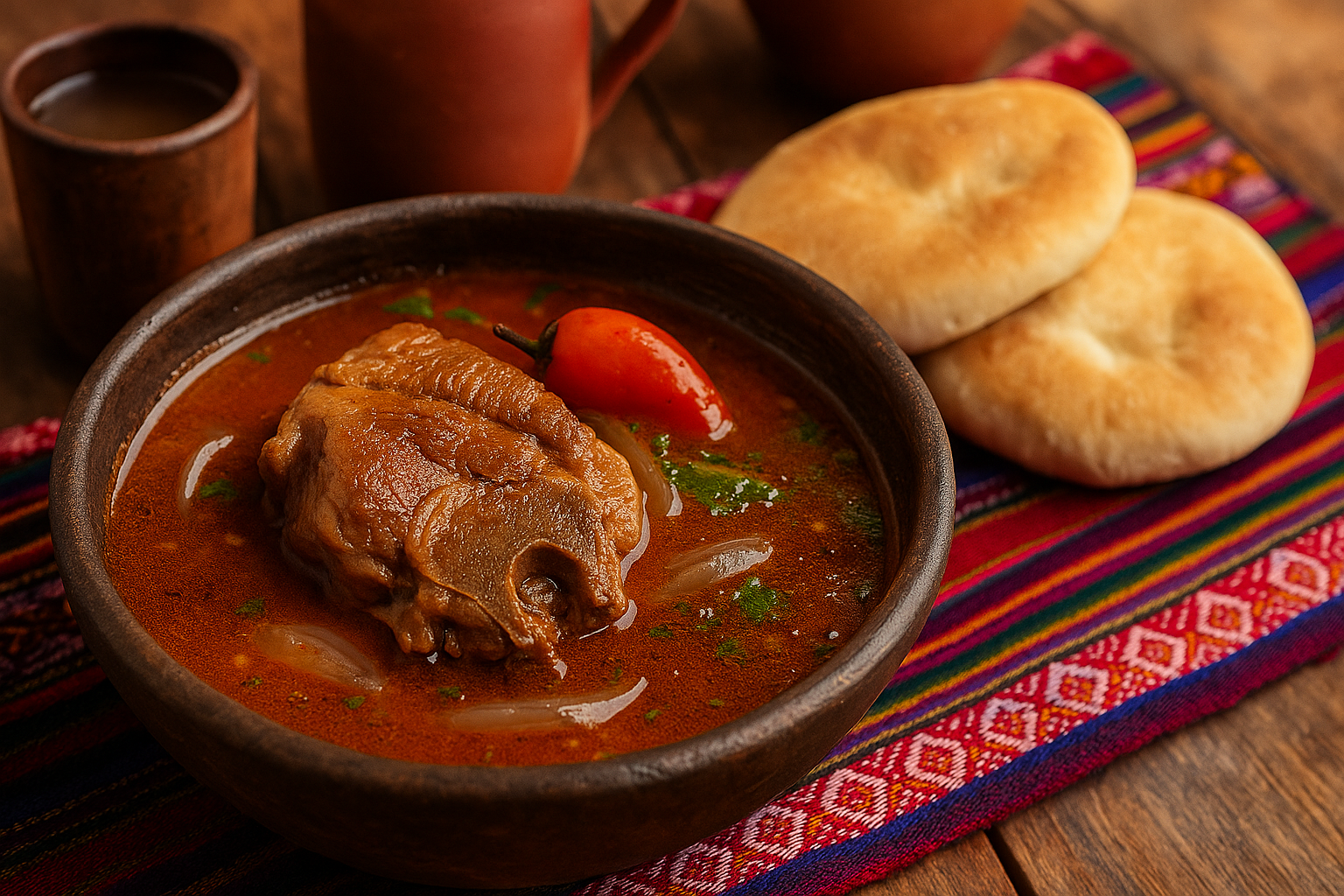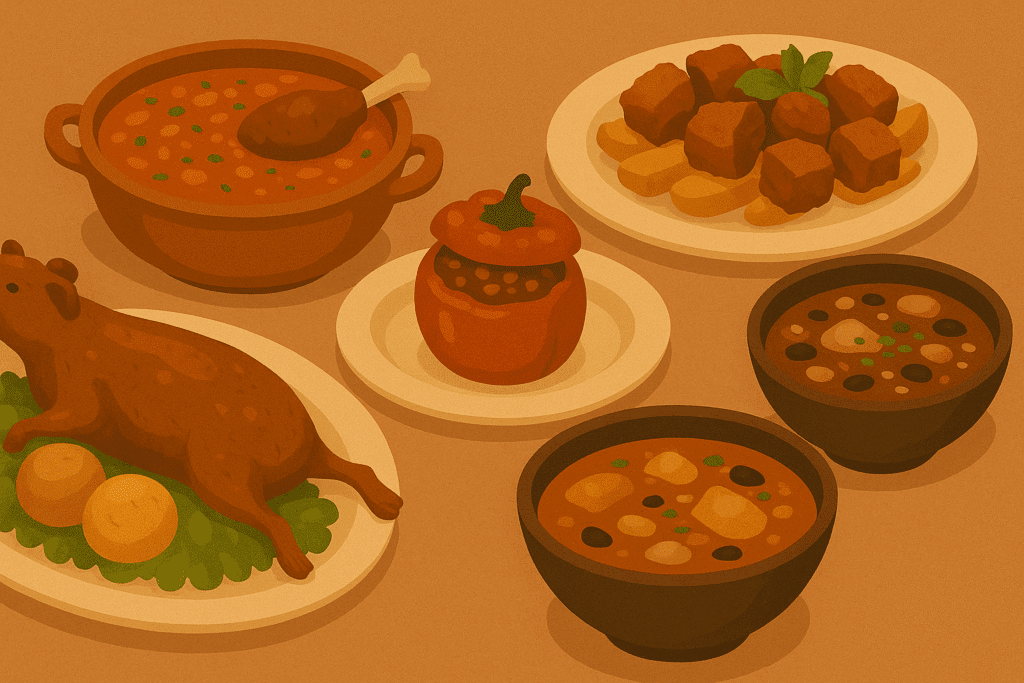Adobo cusqueño is a dish that you don't just eat; you experience it. If you've ever spent a Sunday morning in Cusco, then you've surely encountered its aroma wafting from a picantería or a family home. It's intense, tasty, and warm, and it has a lot of history behind it. Read on for everything you need to know, from its origin to how to prepare it yourself at home.
The term "adobo" comes from Old Spanish and refers to a technique of marinating meat with vinegar, chili peppers, spices, and other ingredients. Though the name does not come from Quechua, the dish is an excellent example of culinary fusion, combining Spanish techniques with Andean ingredients like chicha de jora and ají panca.
📜History
Adobo cusqueño originated during the Viceroyalty period. This special stew emerged at the intersection of Hispanic and Andean cultures. The Spaniards liked marinades and pickles, and the Cusqueños added chicha de jora, local chili peppers, and pork to the mix.
Over time, it became a Sunday morning tradition in the city's traditional neighborhoods, such as San Jerónimo, San Sebastián, and Yanahuara. The ritual? Early Mass, followed by a hot cup of adobo and serrano bread. It's so simple yet powerful.
💊 Curiosities
- It is served in deep plates, and it is common to eat it as if it were soup.
- Many consider it the best hangover remedy because of its fat, salt, and replenishing broth.
- Although it shares the same name, it is very different from adobo arequipeño. es muy distinto al adobo arequipeño.
- The chicha de jora not only gives flavor: it also tenderizes the meat and balances the dish with its acid touch.
📍Importance
Beyond its flavor, adobo cusqueño is a symbol of identity and tradition. It is prepared at patron saint festivals, carnivals, family reunions or simply to enjoy a cold Sunday in good company.
To gather to eat adobo is to share stories, embrace the cultural heritage and keep alive the customs that define the people of Cusco.
📌 Ingredients
This dish needs time, patience and love, like any good tradition.
| 🛒 Ingredients | 📌 Quantity for 4 diners. |
|---|---|
| Pork (Loin) | 1 kl |
| Jora chicha | 0.5 lt |
| Vinegar | 1 tablespoon |
| Cinnamon bouquet | 1 |
| Bunch of fresh oregano | 5 |
| Dried oregano | 1/4 tablespoon |
| Ground garlic | 1 tablespoon |
| Onion | 1 |
| Black peppercorns | 4 |
| Cloves | 4 |
| Rocoto | 1 |
| Cumin grains | 10 |
| Ají panca | 1 |
| Salt | to taste |
| Oropesa Bread | 4 |
🍲 Preparation
Although it is not cooked all together, this dish requires advance preparation. Here's how to assemble it step by step:
- In a large bowl, combine the chopped pork with the chicha de jora, aji panca, ground garlic, cumin, oregano, bay leaf, vinegar, salt, and pepper. Mix well, then marinate in the refrigerator for at least 6 hours. For best results, leave it overnight to allow the flavors to absorb.
- Heat a little oil in a large pot and sauté the onion slices until they are transparent and lightly browned. This step adds sweetness and aroma to the stew.
- Add the contents of the marinade (pork and liquid) to the pot with the onions. Stir and bring to a simmer. Cover and cook over very low heat for 1.5 to 2 hours, stirring occasionally.
🍴 How is adobo cusqueño served?
Cusquenian adobo is served very hot in deep plates or bowls. It is served with oropesa or homemade serrano bread. Some people cut the bread into pieces and soak them in the broth, while others use the bread to scoop up the meat and absorb the juice. Both methods are tasty and valid.
❓Difference between adobo cusqueño and adobo arequipeño
Although they share the same name, Cusqueño and Arequipeño adobos are quite different. Both are emblematic dishes of their respective regions, but they differ in terms of ingredients, preparation, and the time of day they are typically consumed.
Adobo Cusqueño
- It is prepared with chicha de jora, which gives it a deeper and more acidic flavor.
- It is served especially on Sunday mornings as a traditional breakfast.
- It has a more brothy texture and is accompanied with serrano bread or three-pointed bread. pan serrano o pan de tres puntas.
- It is cooked slowly, ideally in clay pots, and has a more spicy and herbal flavor profile.
Adobo Arequipeño
- Vinegar or chicha is used, but with a sweeter and less acid result.
- It usually contains aji panca and rocoto, which gives it a spicier and smoked flavor.
- It is eaten at any time of the day, especially at lunchtime or on holidays.
✨ Conclusion
Adobo cusqueño is more than just a stew; it reflects the history, cultural blending, and warmth of Cusco. Preparing it requires time and patience, but the result is a comforting dish for the body and soul.
Preparing it at home honors tradition. Serving it at the table is a way to bring our loved ones together. Tasting it in a Cusquenian picantería is a way to experience the living soul of the Andes.
If you're in Cusco on a Sunday morning, don't hesitate: Go to a picantería and order a bowl of adobo. You can also prepare it yourself and enjoy it with good conversation and freshly baked bread.





